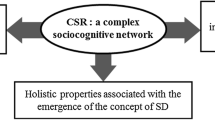Abstract
The paper observes that the term ‘business model’ has been incorporated in recent financial reporting regulations. The first section of the paper describes various meanings of ‘business model’ and demonstrates that the term has no settled or agreed meaning. The second part of the paper considers the suitability of the term ‘business model’ as a basis for a measurement standard (IFRS 9) or for requirements for narrative reporting and concludes it is not suitable for either purpose. Examples from the UK FTSE 100 index companies are used to illustrate existing usage in narrative reporting, finding varying levels of informativeness of disclosures about business models. The final part of the paper discusses reasons for incorporating an ambiguous and contested term in reporting guidance. It identifies parallels with ambiguity in other branches of financial reporting and the potential utility of ambiguity in allowing consensus to be arrived at on a form of words, apparently tightening up reporting regulation, while allowing participants ‘wiggle room’.
Similar content being viewed by others
Notes
Note the emphasis on the contractual characteristics rather than the substance of the arrangements.
This characterisation seems to embrace ‘value’ as both a stock and a flow. Generating value seems to imply a flow, whereas preserving value seems to imply a stock.
It is very difficult to write about strategy without ascribing to organisations human traits of wants and desires, intent, objectives and so on. For the most part this article will adopt such a ‘pathetic fallacy’ but it needs to be borne in mind at all times that ‘Company X’s objective is Y’ is probably best interpreted as ‘The senior management of Company X would like people to believe that the company will act in a way that is consistent with the achievement of objective Y’. Clearly the management of Company X may be lying, or deceiving themselves, and other people in the organisation may be working to achieve other objectives so that the behaviour of the organisation may turn out not to be consistent with the announced objective.
Because of discontinuities arising from regulation and agreements entered into by firms, there is no general fixed point theorem that says that there will be a market price of an item and a value reported by a company that is consistent with that price, or if there is such a price, that it will be unique. For example, there is the possibility that reporting values of items will be self-negating. Suppose a company has a choice of two measurements of a liability and that if it chooses the higher value, the market will be nervous about the company’s stability and mark down the liability. If the company chooses the lower value of the liability then the market will be reassured and the company will eventually discharge the full value. There is no value for the liability that the company can report that is consistent with the eventual realisation.
Note that there is clear duplication with the ASB (2006) guidance which nevertheless remains in force.
For example, the draft definition of an asset in the IASB’s conceptual framework project defines the once reasonably well understood term ‘asset’ concepts of concepts of ‘present right of other access’, ‘economic economic resource’ ‘generating’ and ‘economic benefits’ that themselves will become the subject of debate and elaboration.
A lurid kind of nineteenth century periodical for teenagers that published serialised, cliff-hanger adventure stories.
References
Accounting Standards Board. (2006). Reporting statement: Operating and financial review. London: ASB.
Alfredson, K., Leo, K., Picker, R., Pacter, P., Radford, J., & Wise, V. (2007). Applying international financial reporting standards enhanced edition. Milton, Queensland: Wiley.
Baden-Fuller, C., & Morgan, M. S. (2010). Business models as models. Long Range Planning, 43(2–3), 156–171.
Clayton, R. (2007). SOCA: We just want your money? (Electronic Version). Retrieved 13 July 2010 from http://www.lightbluetouchpaper.org/2007/02/11/soca-we-just-want-your-money/.
Demil, B., & Lecocq, X. (2010). Business model evolution: In search of dynamic consistency. Long Range Planning, 43(2–3), 227–246.
Financial Reporting Council. (2010). The UK corporate governance code. London: Financial Reporting Council.
Harford, T. (2011). Adapt: Why success always starts with failure. London: Little, Brown.
Internal Control Working Party (Turnbull Report). (1999). Internal Control: Guidance for directors on the combined code. London: Institute of Chartered Accountants in England and Wales.
International Accounting Standards Board. (2009a). IFRS 9 “Financial Instruments”. London: International Accounting Standards Board.
International Accounting Standards Board. (2009b). Exposure draft: Management commentary. London: International Accounting Standards Board.
Kay, J. A. (2011). What Europe can learn from kissinger-style ambiguity (Electronic Version). Retrieved 19th October 2011 from http://www.johnkay.com/2011/10/05/what-europe-can-learn-from-kissinger-style-ambiguity.
Malone, T. W., Weill, P., Lai, R. K., D’Urso, V., Herman, G., Apel, T. G., et al. (2006). Do some business models perform better than others? Unpublished Working paper. MIT.
Morris, M., Schindehutte, M., & Allen, J. (2005). The entrepreneur’s business model: Toward a unified perspective. Journal of Business Research, 58(6), 726–735.
Page, M., & Spira, L. F. (2005). Ethical codes, independence and the conservation of ambiguity. Business Ethics: A European Review, 14(3), 301–316.
Parmalee, N. (2007). Unilever versus Diageo: Diageo (Electronic Version). Retrieved 13th July 2010 from http://www.fool.com/investing/general/2007/03/16/diageo-vs-unilever-diageo.aspx.
Penman, S. H. (2007). Financial reporting quality: is fair value a plus or a minus? Accounting & Business Research, 37(Special Issue: International Accounting Policy Forum), 33–44.
SEC. (2002). Proposed rule: Disclosure in management’s discussion and analysis about the application of critical accounting policies. Retrieved 15 July 2010, from http://www.sec.gov/rules/proposed/33-8098.htm.
Spira, L., & Page, M. (2009). Regulation by disclosure: The case of internal control. Online first: Journal of Management and Governance.
Teece, D. J. (2010). Business models, business strategy and innovation. Long Range Planning, 43(2–3), 172–194.
Tesco. (2009). Business review (Electronic Version). Retrieved 13th July 2010 from http://www.tescoplc.com/annualreport09/businessreview/business_model/.
Author information
Authors and Affiliations
Corresponding author
Rights and permissions
About this article
Cite this article
Page, M. Business models as a basis for regulation of financial reporting. J Manag Gov 18, 683–695 (2014). https://doi.org/10.1007/s10997-012-9239-0
Published:
Issue Date:
DOI: https://doi.org/10.1007/s10997-012-9239-0




